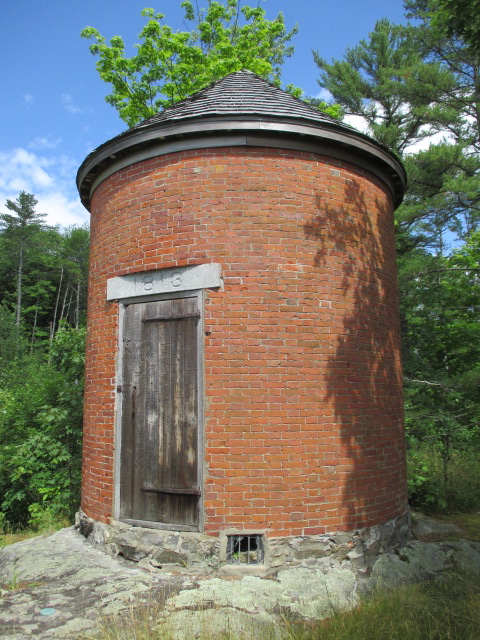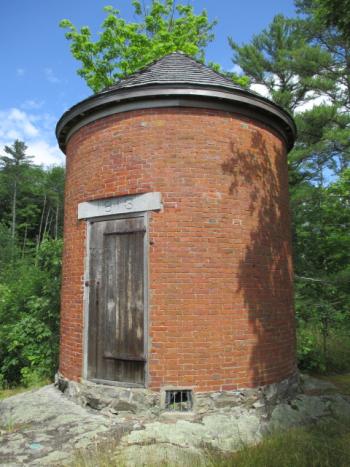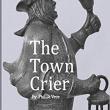Wiscasset’s Phil Di Vece: Still finding ‘positive’ history
 Look familiar? When Phil Di Vece had his newspaper Wiscasset Times, he had this figurine custom-made as part of the sign. Now it is on the cover of Di Vece’s latest book. Courtesy image
Look familiar? When Phil Di Vece had his newspaper Wiscasset Times, he had this figurine custom-made as part of the sign. Now it is on the cover of Di Vece’s latest book. Courtesy image
 Wiscasset’s 1813 Powder House off Churchill Street gets a chapter in Phil Di Vece’s 2020 collection of local history stories, “The Town Crier.” File photo
Wiscasset’s 1813 Powder House off Churchill Street gets a chapter in Phil Di Vece’s 2020 collection of local history stories, “The Town Crier.” File photo
 Look familiar? When Phil Di Vece had his newspaper Wiscasset Times, he had this figurine custom-made as part of the sign. Now it is on the cover of Di Vece’s latest book. Courtesy image
Look familiar? When Phil Di Vece had his newspaper Wiscasset Times, he had this figurine custom-made as part of the sign. Now it is on the cover of Di Vece’s latest book. Courtesy image
 Wiscasset’s 1813 Powder House off Churchill Street gets a chapter in Phil Di Vece’s 2020 collection of local history stories, “The Town Crier.” File photo
Wiscasset’s 1813 Powder House off Churchill Street gets a chapter in Phil Di Vece’s 2020 collection of local history stories, “The Town Crier.” File photo
“The Town Crier” took Phil Di Vece longer than his first two books on Wiscasset’s history. He never planned a third one. It happened because he had so much material left after “Wiscasset and Its Times – Stories of Maine’s Prettiest Village” and “More Wiscasset and Its Times”; and because readers’ reaction was overwhelmingly positive, including asking when the next would come out.
He got emails from all over the country. “People just loved (the first two) so much ... I’m very humbled.”
Formatting “Crier” took 18 months; and the book got its copyright before the COVID-19 pandemic took hold in the U.S. “Fortunately, we got all that done before things sort of shut down.”
Fans may want to savor “Crier.” The Wiscasset Newspaper news contributor, 64, said Wiscasset has a lot more history to write about but he doesn’t expect to do another book on it for quite a while. “Maybe fiction, it might be nice to go back and explore that again.” Di Vece’s first book, “King of the Bay,” was fiction. Besides writing books, he still enjoys writing for the newspaper, he added.
The books on Wiscasset’s history were fun to write and are fun for him to read. “My goal was to put out something positive about Wiscasset’s history.” He would advise prospective authors to do like he did: He wrote about something he enjoys – the history of the area he loves and plans to keep living in.
Some of the new book’s chapters stem from Di Vece’s historical pieces that have appeared in Wiscasset Newspaper, including ones on Wiscasset’s powder house, former business The Milk Shed and ice harvesting. A chapter on the mystery of Money Hole Gully is brand new and took a lot of research, Di Vece noted. “It was just sort of a legend. But you know, with any legend, there’s always a little fact. And the facts bore out the legend, basically. There really was a Money Hole Gully, and it’s still there today.”
According to Di Vece’s research, the gully, over the Dresden line into Pittston, has been the site of deep digging for treasure, supposedly Captain Kidd’s. In telling the mystery, Di Vece shares his efforts to track it, including catching up with a past Wiscasset adult education photography student of his, Dresden icon Eleanor Everson.
“I reached Eleanor by telephone one July afternoon,” Di Vece writes in “Crier.” “It was one of those uncomfortable sultry days when it takes all morning for the haze to burn off and after it does it gets uncomfortably hot and humid. “Well,’ she began a little surprised to hear from me after so long. ‘Money Hole Gully is just up the road from where I was born, raised and still live. But I don’t know that I can tell you too much about it except that it’s always been called that at least as long as I’ve been here and you probably know I go back quite a ways.”
Di Vece believes his reporting – including for his newspaper Wiscasset Times for years and now his longtime work for Wiscasset Newspaper – has aided him as an author: Both pursuits take good listening and building rapport with their subjects, he said. Growing up, he liked reading the dictionary and was fascinated with words’ origins. That love of words led him to write.
In their 40 years of marriage, he and Marjorie Di Vece have moved from Westport Island to Edgecomb and, in 1984, to Wiscasset’s Langdon Road. “I think this area, not just Wiscasset but this whole little area that we live in, I don’t want to live anywhere else. We were just talking about that. This is a really nice, nice place to call home.”
Di Vece took many of the new book’s 50-plus photos. He said the type is easy to read. Di Vece’s son, Bytes.com co-founder Jason Di Vece of Burlington, Vermont, designed the book, available at Ames True Value in Wiscasset, Sherman’s Bookstores in Boothbay Harbor and Damariscotta, and at Amazon.com
Event Date
Address
United States

























